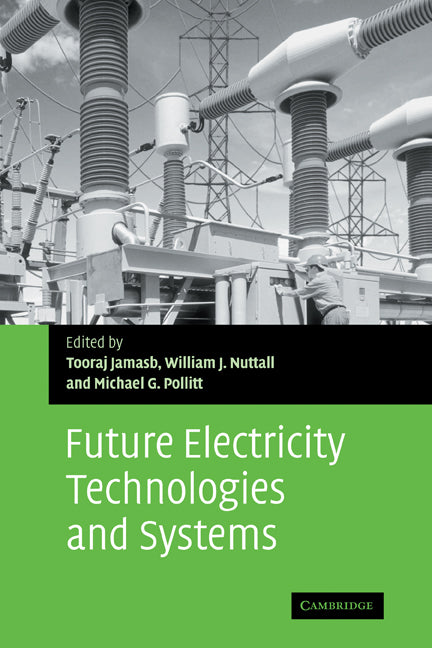Freshly Printed - allow 8 days lead
Couldn't load pickup availability
Future Electricity Technologies and Systems
An authoritative overview of the main technologies which could shape the future of electricity.
Tooraj Jamasb (Edited by), William J. Nuttall (Edited by), Michael G. Pollitt (Edited by)
9780521860499, Cambridge University Press
Hardback, published 20 July 2006
456 pages, 15 b/w illus. 48 tables
23.6 x 15.9 x 3.5 cm, 0.86 kg
'It's a pleasure to see a book on future electricity systems that foreswears the narrow advocacy of particular technologies and provides an authoritative account of all the options that may be needed in the coming decades. Renewables, nuclear and fossil all have their place in this book which not only deals with demand-side options but places individual technologies in a whole systems context. With energy now a key policy concern, this could become a standard reference for students and practitioners alike.' Jim Skea, Research Director, UK Energy Research Centre
Where will our electricity come from in the future, and how will we use it? The UK is aiming for a 60% reduction of 1990 carbon dioxide emission levels by 2050, yet the electricity industry and patterns of electricity use must change radically if this is to be achieved. This authoritative overview analyses a range of possible scenarios for the future of electricity in the UK. Specialists in various renewable electricity technologies demonstrate the potential each has to play a significant role. Other routes to a low-carbon electricity system are also considered, including nuclear power, improved power electronics, a wider use of superconducting technology, and micro-generation systems including combined heat and power. The book concludes by examining opportunities for demand side improvements in architecture, industry and transport. Each chapter is written by a technical expert in a manner accessible to readers interested in energy technology, policy and economics.
Figures
Tables
Notes on contributors
Preface Michael Grubb and Janus Bialek
Acknowledgements
List of abbreviations
1. New electricity technologies for a sustainable future Tooraj Jamasb, William Nuttall and Michael Pollitt
2. Electricity network scenarios for the UK in 2050 Ian Elders, Graham Ault, Stuart Galloway, Jim McDonald, Jonathan Köhler, Matthew Leach and Efterpi Lampaditou
3. Wind power: status and perspectives Poul Erik Morthorst
4. Solar energy: photovoltaic electricity generation Asim Mumtaz and Gehan Amaratunga
5. Bioenergy: future prospects for thermal processing of biomass Anthony V. Bridgwater
6. Wave energy Tom Thorpe and Robin Wallace
7. CO2 capture, transport and storage for coal, oil and gas: technology overview Nils A. Røkke
8. Nuclear energy Malcolm C. Grimston
9. Miniaturisation of the electricity generation industry: issues, technologies and potential Andreas Biermann
10. Superconductors in the electrical power industry A. M. Campbell
11. The role of power electronics in future power systems T. C. Green and C. A. Hernández Arámburo
12. Sustainable hydrogen energy Peter P. Edwards, Vladimir L. Kuznetsov, Simon R. Johnson, Matthew T. J. Lodge and Martin Owen Jones
13. Electrical energy storage A. J. Ruddell
14. End-use technologies - main drivers and patterns of future demand: buildings Wolfgang Eichhammer
15. Industry Lynn Price, Christina Galitsky and Ernst Worrell
16. Transport Pieter Vermeyen and Ronnie Belmans
17. Prospects for smart metering in the UK Hannah Devine-Wright and Patrick Devine-Wright.
Subject Areas: Environmental science, engineering & technology [TQ], Environmental economics [KCN]


